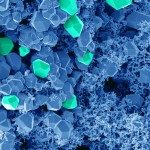About
The genes pknA and pknB are located near the origin of replication in M. tuberculosis and are part of a conserved operon that also includes pstP (coding the only known Ser/Thr protein phosphatase in M. tuberculosis), rodA (a cell shape determinant), pbpA (a peptidoglycan-synthesizing enzyme) and fhaB (a membrane-bound FHA protein similar to GarA). We solved the structure of the catalytic domain of PknB in 2003 (Ortiz-Lombardia et al., 2003) and we later demonstrated that the pknB gene is essential to sustain M. tuberculosis growth in vitro (Fernandez et al., 2006). Experimental evidence points to the involvement of both PknA and PknB in the control of cell wall synthesis and cell division, possibly through the control of peptidoglycan synthesis and remodelling (Kang et al., 2005; Kang et al., 2008; Thakur and Chakraborti, 2008; Fiuza et al., 2008; Parikh et al., 2009). However, the signalling network and the molecular properties of the mycobacterial cell divisome (which differ substantially from those studied in E. coli or B. subtilis) remain largely unknown.
Our structural studies confirmed that the overall fold and catalytic mechanisms of mycobacterial kinases are highly similar to their eukaryotic counterparts (Ortiz-Lombardia et al., 2003; Wehenkel et al., 2006), and we also showed that autophosphorylation of the activation loop increases PknB kinase activity (Boitel et al., 2003; Duran et al., 2005). We are pursuing our structural, mutagenesis and biochemical studies of PknA, PknB and their complexes to further investigate the structural basis of kinase activation, in particular to probe the possible role of back-to-back homodimerization or PknA/PknB heterodimerization in regulation. We are also involved in a drug-design effort on PknB, for which we are studying kinase-inhibitor complexes with ATP-competitive inhibitors produced by our collaborators (NM4TB integrated project, FP6 program; MuKIT, ANR-funded project).Another open issue that we are trying to elucidate is the nature of the activating signal. While PknA has no extracellular domain, the sensor domain of PknB is made of four repeated PASTA domains, small β-sheet modules conserved in homologous transmembrane kinases from many bacteria. Initial speculations that these domains might bind muropeptides (Yeats et al., 2002) are now supported by the observation that B. subtilis PrkC, a PknB homolog, is responsible to induce spore germination in response to peptidoglycan fragments (Shah et al., 2008). To gain further insights on similar processes in mycobacteria, in collaboration with R. Brosch’s and S. Cole’s teams we are studying protein-ligand interactions of recombinant PASTA domains from M. tuberculosis PknB with synthetic muropeptides, as well as with different mycobacterial cell wall fractions. We are also producing specific pknB mutant strains of M. smegmatis or M. tuberculosis with modified PASTA domains, for localization and phenotypic studies.
Funding: NM4TB, ANR (projects: TBKIN, MuKIT)
Collaborations:
Roland Brosch, Unité de Pathogénomique mycobactérienne intégrée, Institut Pasteur, Paris
Stewart T. Cole, Global Health Institute, EPFL, Lausanne




